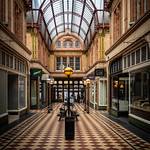- BBC Radio 2 In The Park confirmed as Preston’s mystery music festival
- Preston City Council local elections 2024 candidates list set out
- Blog Preston reaches crowdfunding goal for expanded arts and culture coverage
- Harris Institute owners move to squash ‘for sale’ rumours
- “Unacceptable” and “must do better” as Preston records highest rough sleeper count since records began
Insurrection in Preston, gangs stop the mills
Posted on - 6th March, 2022 - 7:00pm | Author - Geoffrey Whittaker | Posted in - History, Preston City Centre, Preston News
After a Chartist petition to bring in political reforms was thrown out by parliament, in 1842, insurrection spread across the North West. Notably, this was encouraged by Chartist leader and Prestonian Richard Marsden. Marsden described himself as a ‘white slave’ and was a hand loom weaver.
AdvertisementA general strike had been called and by early August the movement had crossed the Ribble and entered Preston. Authorities were caught off guard as groups of men entered factories and pulled the plug on the steam engine boilers.
What was Chartism?

In 1832 voting reform gave more power to individuals, however most of the working class were still not represented. Therefore, in 1836 a movement began that had several aims:
- A vote for all men (over 21)
- The secret ballot
- No property qualification to become an MP
- Payment for MPs
- Electoral districts of equal size
- Annual elections for Parliament
After a long struggle reforms were eventually enacted in 1867 and 1884, and most of the Chartist demands were met.
Reform clubs

In celebration of the victory, reform clubs were built around the country. The best known is the Reform Club in London, however provincial towns and cities also had them.
Later in the century reform clubs were built in Preston and Manchester. They were basically gentleman’s clubs where the liberal elite met. After World War I the liberal consensus broke and the clubs fell out of favour. Some became social clubs, as did the old reform club in Chapel Street near Winckley Square.

This building is now seeking permission to be converted into flats. Other Winckley Square buildings have already been converted. For example, 20 Charter House has two bedroom flats for sale, for £180,000. This area is still gentrified in the 21st century. For example, an entire terraced house can be had, in less desirable areas, for £50,000.

Chartism makes a move

Chartist petitions were used as a means of pressuring the Government; three were presented to Parliament, in 1839, 1842 and 1848. All of them failed to effect any changes. The authorities feared a revolution, therefore heavy handed tactics were used to suppress riots and insurrection.
1842 was also a year of unemployment and near starvation, wages were cut and discontent boiled over into rioting. Preston was one town that saw casualties amongst striking workers.
Chartism in the North West
In 1837, The Preston Operative Radical Association was formed. They soon had 200 members and organised a great rally. In 1838, the rally led to a large procession that marched through the town and met on Preston Moor. Richard Marsden spoke of the need for workers to ‘reclaim their rights’.
Marsden also spoke at the great national Chartist convention in London. He said that, in one street in Preston, ‘twenty muskets had been purchased’. Unfortunately, this ill-advised comment led the military to fear insurrection and fire on rioters in the subsequent Preston riots.

The Preston Insurrection

In May 1842 the second Chartist petition was thrown out and the plug strikes began. Lancashire became a flash point as gangs entered the mills and ‘pulled the plug’. Next, on 12 August, the Ribble was crossed and a meeting arranged at the Orchard. Consequently, an attack was made on Sleddons Mill. The workers were turned out and the mill stopped.
The bloodiest incident happened at 12 o’clock as rioters gathered between Wharf Street and Fleet Street. They attempted to pass further up Lune Street where the police and military were waiting.
Scuffles ensued and five rioters were killed. More battles occurred over the coming weeks.
The aftermath
Richard Marsden reported in The Northern Star. He described ‘our humiliated town of Preston, where the Well-known Peterloo tragedy hath just been re-enacted’. However, by the end of the century all the Chartist demands were met except for annual Parliaments.
Read more: See the latest Preston news and headlines











 Advertisement
Advertisement